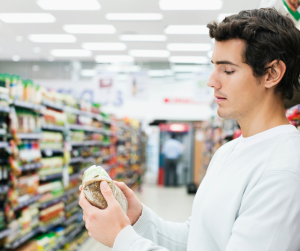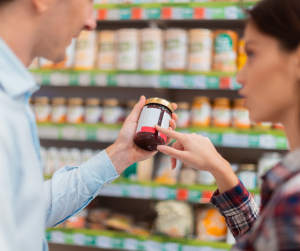Nutrition labels are very valuable because what you eat and put into your body is important. People need to be informed and control what they eat for both meals and snacks. One of the best ways to do this is to read food labels. MyPlate is also a great tool created to help us eat healthier. https://www.myplate.gov/
The front, back, top, bottom and the sides of a food package or container are filled with information on what the food contains. Basically, nutrition labels can help us to make wise food choices, for our individual health and wellbeing.

I’ve been reading nutrition facts panel labels for years. They have improved over time, relying on research-based information and comments from the public. The changes are meant to make labels easier to read, interpret, and be more helpful to consumers when making nutrition and health choices. The label has undergone revisions, and the newest label came out in 2016. Manufacturers had until 2020 to update their labels.
The Nutrition Facts label is overseen by the U.S. Food and Drug Administration (FDA) and was first mandated under the Nutrition Labeling and Education Act of 1990 to help consumers make quick, informed food choices.
Changes to the Nutrition Facts Label | FDA
https://www.fda.gov/food/nutrition-education-resources-materials/nutrition-facts-label
Do people read food labels?
Many people do take a closer look at nutrition labels, while others don’t consistently take the time to study them. We are a fast-paced society and people are constantly on the go. With the increase in online shopping and internet-based grocery delivery services, the consumer may have someone else purchase their items without looking at the nutrition facts panel. Many busy people just want to get in and out of the grocery store as quickly as possible, and they don’t take the time to look.
The biggest concern is that people do not know how to interpret what is written on labels. They get confused about the milligrams in a serving. They don’t know their individual targets for vitamins, minerals, calories, serving size and/or daily allowances. They also don’t know how to interpret all the numbers and percentages and what it all means. Sometimes, all the printing, numbers, percentages, and complicated ingredient names can be overwhelming and make some people even more confused.

The print size can be too small to read for people with vision impairments, despite a recent increase in the font size. I tell people to get out their magnifying glass and take a closer look. Nutrition and health matters.
We at UF/IFAS Extension want people to increase awareness of their diet and nutritional intake, and not overlook nutrition labels. Label reading can be a key component to better health and better quality of life. People can also request a nutrition consultation with a Registered and/or Licensed Dietitian, or from their healthcare provider, to clarify any specific questions they may have on their individual nutritional needs.

Five (5) tips when reading food labels
- First look at the label on the front of the package. This is the section consumers see first, which can influence its purchase. Then take a closer look at the entire package.
2. Review the list of ingredients. The FDA oversees the ingredients listed on food labels. A packaged food must list the ingredients in order of predominance by weight.
3. Scan the serving size and calories per serving listed on the packaging. This information is bolded and in a larger font. The label lists the calorie amount for one serving of food. Serving sizes have been updated to list amounts that more currently and realistically reflect what consumers eat. Serving size is not a recommendation for everyone about how much to eat, but rather a reference point. Control your individual intake based on your personal nutritional needs.

4. What about Vitamins A and C, and the addition of Vitamin D and potassium to the nutrition label? Vitamins A and C had been previously included in labels when deficiencies of these nutrients were more common. They are rare today, so they have been replaced with Vitamin D and potassium, which can run low in the diets of some Americans.
5. The % Daily Value can be very helpful, although it can also be confusing. It shows how much of a nutrient is in one serving of a particular food. This contributes to an individual’s approximate daily requirement for the nutrient. % Daily Value is based on an average of a 2000 calorie per day diet. (That is 2000 calories per day, not per meal.) Daily Values are average levels of nutrients based on a person who eats 2,000 calories a day. A food item with a 10% DV of fat provides 10% of the total fat that a person who needs 2,000 calories a day should eat. Some people need more calories and others need less. It is a specific balance. Know your individual daily calorie and nutrient needs. Calculate basic needs here: https://www.myplate.gov/myplate-plan
Nutrition labels
There are labeling guidelines manufacturers are required to follow. The calories per serving, the type of fat used, and the amount of added sugars can add up. Portion control also matters. https://blogs.ifas.ufl.edu/browardco/2023/01/13/portion-control-matters-portion-size-matters/

Food allergies
People with food allergies need to read labels to avoid an allergic reaction. The nine main food allergies are: milk, eggs, fish, crustacean shellfish, tree nuts, peanuts, wheat, soybeans and sesame. https://sfyl.ifas.ufl.edu/media/sfylifasufledu/miami-dade/images/community-r-dev-/Food-Allergies-and-Food-Allergens-Sesame–(1).pdf
Conclusion and final thoughts
It is in your best interest to look at calories, serving size, ingredients, and any special notes on allergies, etc. For specific diseases you may want to look for added sugars, trans-fat, and/or sodium content, and control the amount consumed.
My recommendation is to get in the habit of reading food labels. Read articles such as this one to increase your knowledge. The nutrition facts panel is laid out the same and should be consistent from product to product. The more you read labels, the quicker you will get at interpreting them. If you make label reading a habit, you’ll become more familiar with it.

Heavily processed foods often contain unhealthy amounts of fats, added sweeteners, and/or excess salt. Research suggests this may have a negative effect on health. All foods can fit into a well-balanced diet that is varied in vitamins, minerals, and nutrients. Moderation is key. Families and consumers need to understand labels. It takes effort to interpret and understand nutrition labels.
I really like the statement: Eat closer to the farm, and further from the factory. Fresh food and fresh ingredients have less processing and less preservatives added to them. For example, an apple, orange, fresh piece of chicken, or fish, fresh green beans and carrots have only one ingredient. They are simple to decipher!
We all come in different shapes and sizes and have different aspects of our health to consider. We need to understand our own nutritional needs throughout the lifecycle. Some people have medical conditions or diseases requiring them to take into account any special dietary needs. Always follow the advice of your health care provider and ask questions during your visits.
Make wise food choices, read food labels, and enjoy the benefits of healthy eating.
For more information:
https://blogs.ifas.ufl.edu/browardco/2019/11/13/sodium-intake-and-blood-pressure/
https://blogs.ifas.ufl.edu/browardco/2023/06/01/control-your-cholesterol/
https://blogs.ifas.ufl.edu/browardco/2023/07/05/dietary-fiber/
https://blogs.ifas.ufl.edu/browardco/2023/06/25/calcium-and-vitamin-d-are-important-nutrients/
https://blogs.ifas.ufl.edu/browardco/2023/06/06/eat-foods-with-healthier-fats/
https://blogs.ifas.ufl.edu/browardco/2023/06/02/all-about-saturated-fat/
The mission of the University of Florida Institute of Food and Agricultural Sciences (UF/IFAS) is to develop knowledge relevant to agricultural, human and natural resources and to make that knowledge available to sustain and enhance the quality of human life. With more than a dozen research facilities, 67 county Extension offices, and award-winning students and faculty in the UF College of Agricultural and Life Sciences, UF/IFAS brings science-based solutions to the state’s agricultural and natural resources industries, and all Florida residents.
An equal opportunity institution.
 16
16
